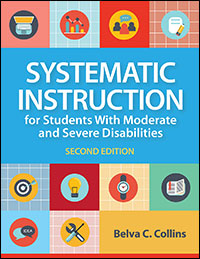6 Ways to Be a Special Education Teacher Leader
October 17, 2023
 In her book Systematic Instruction for Students with Moderate and Severe Disabilities, Belva C. Collins describes how special educators can use dynamic, evidence-based systematic instruction strategies to teach core content that is age-appropriate, meaningful, and relevant to students’ lives. Systematic instruction can improve outcomes for students with moderate and severe disabilities—and as a side effect, special educators who become skilled in systematic instruction have the potential to emerge as leaders in their schools, their districts, their states, and their profession.
In her book Systematic Instruction for Students with Moderate and Severe Disabilities, Belva C. Collins describes how special educators can use dynamic, evidence-based systematic instruction strategies to teach core content that is age-appropriate, meaningful, and relevant to students’ lives. Systematic instruction can improve outcomes for students with moderate and severe disabilities—and as a side effect, special educators who become skilled in systematic instruction have the potential to emerge as leaders in their schools, their districts, their states, and their profession.
In today’s post, excerpted and adapted from the book, we offer 6 possibilities for leadership roles special educators can take when they’ve mastered the art of systematic instruction.
Demonstrate Leadership as a Data-Based Decision Maker
Special education teachers who understand how to use systematic instruction can demonstrate leadership by collecting baseline data to demonstrate the effectiveness of instruction, using systematic instruction procedures with a high degree of fidelity, and making instructional decisions based on three to five sessions of graphed data. Special education teachers can also compare efficiency data to determine which procedure is best to use in teaching specific types of skills to learners with various needs and degrees of ability. It’s important that special educators stay current on research from legitimate sources to support the practices they use.
Demonstrate Leadership Within the School
In addition to showing leadership within the classroom, special education teachers can be valuable leaders within their schools by volunteering to be team members in school initiatives. Their skills as data-based decision makers, as well as their knowledge and background in effective practices, can help ensure that learners with disabilities are included in and benefit from these initiatives. For example, special education teachers can advocate for ways to implement inclusive practices that are likely to be successful (e.g., embedding systematic instruction).
Demonstrate Leadership by Mentoring Others
Special education teachers can be strong mentors in teaching others to implement systematic instruction. This may include general education teachers, paraprofessionals, peer tutors, related service personnel, family members, and preservice teachers. The skills needed to conduct effective systematic instruction also can translate to effective mentoring, such as maintaining attention, providing clear directions, prompting responses, and giving sufficient feedback. Special education teachers should remember that they are role models for others. If others see them implementing strategies that are effective and efficient, it’s likely that they will want to do the same.
Demonstrate Leadership by Sharing Expertise Through Presentations
When the opportunity arises, special education teachers can share their expertise by providing professional development for others, such as teachers across their district. This may even extend to the state or national level. To be effective, these presentations must be well organized with clear objectives and useful activities. For example, a special education teacher may limit a presentation to providing a rationale for using a single response-prompting procedure, modeling the procedure, and then having attendees practice in groups while the special education teacher circulates and offers feedback.
Demonstrate Leadership by Working With Families
Family members and caregivers often struggle with knowing how to best work with their child in the home. Special education teachers can empower them by sharing instructional strategies that are effective and efficient. Instead of overwhelming a family with too much information, it may be best to limit the sharing of strategies to one or two that are easy to implement. The special education teacher can share written materials and resources on the procedures with families and set up times to communicate with them at their convenience. This may involve face-to-face meetings or the use of technology. What is most important is that families receive a sufficient amount of modeling and coaching to be able to implement a strategy with fidelity and to feel comfortable using it to teach a variety of skills that they value.
Demonstrate Leadership During Times of Transition
Although families value support during transitions across their children’s school careers, it may be most important to provide this during the transition from school to adulthood. When sharing transition materials, special education teachers can offer to work with members of the entire transition team in implementing systematic instruction procedures that can help increase independence. This might involve sharing response-prompting procedures with job coaches and future employers or the support personnel who will help with daily living skills (e.g., supported living in an apartment or a college dormitory). In addition, the special education teacher may be able to show how learners can use certain procedures, such as video prompting and video modeling, to facilitate their independence.
Special educators have the potential to be leaders in many different contexts once they’ve mastered systematic instruction. For an in-depth guide to the nuts and bolts of systematic instruction, get the book behind today’s blog post!
Systematic Instruction for Students with Moderate and Severe Disabilities, Second Edition
 By Belva C. Collins, Ed.D.
By Belva C. Collins, Ed.D.
Written by a seasoned educator with decades of experience training thousands of teachers, this is the accessible, up-to-date text today’s teachers need to succeed in inclusive classrooms and improve outcomes for students with moderate and severe disabilities. Educators will discover evidence-based methods that help them with every step of systematic instruction, from collecting accurate screening and baseline data to supporting students as they generalize new skills to other settings.




Write a Comment
Your email address will not be published. Required fields are marked *
Post a Comment